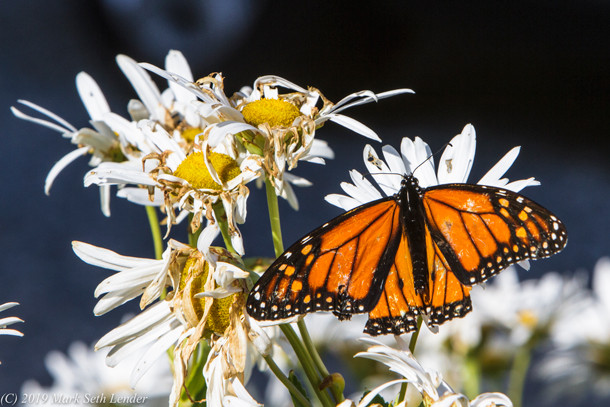Field Note: Monarch Migration
Published: July 26, 2019
By Mark Seth Lender

A monarch butterfly, all worn out. (Photo: Mark Seth Lender)
Living on Earth's Explorer in Residence, Mark Seth Lender muses on the multi-generational migrations of monarch butterflies and on their remarkable return after a hurricane.
Maimonides (1138-1204) was a Sephardic scholar, philosopher, physician to Salah ad-Din (Saladin), and a renowned and revered commentator on the Talmud. In a famous treatise on giving, he said the greatest gift (by which he meant the one that does the greatest good and contributes most to a universal healing) is when the giver and receiver are unknown to each other. By this definition, to give anonymously to future generations is the highest order of gift that can be offered. How perfectly the monarch butterfly, this mere insect, fits that definition.
2018 was a banner year for the monarchs of the Connecticut Shore. They took over every bloom of summer, early, middle and late as the plants in succession came into flower. It was the first time in seven years I saw them in such numbers. After Hurricane Irene there was nothing for monarchs here. The perennials, wild and cultivars both, and even the old beach plumb, the crown of our garden that had grown to the stature of a tree, all were destroyed in a flood of saltwater. After that it was as if the monarchs had forgotten us; this place; the very possibility. Too much time had passed in the season of butterflies for memory to survive. Except for the occasional straggler we thought we had lost them forever.
-and-American-Lady-(Right).jpg)
A buckeye (left) and an American Lady (right). (Photo: Mark Set Lender)
Then, monarchs were everywhere. And they were not alone. The American ladies, paper whites and yellow sulphurs, buckeyes and yellow tigers and black swallowtails, all made their presences known. Even the bees came back in force, many species, and in large numbers.
It is a year later. The milkweed blooming like I’ve never seen, its sweet scent overwhelming. The buddleia are just starting out, their purple so deep it is almost black. The verbena have started. Red bergamot is taking over the yard across the street.
Everything is ready.
It gives us hope.
Listen to Mark Seth Lender read his Monarch Migration essay
Back to Mark Seth Lender Field Notes
Living on Earth wants to hear from you!
Living on Earth
62 Calef Highway, Suite 212
Lee, NH 03861
Telephone: 617-287-4121
E-mail: comments@loe.org
Newsletter [Click here]
Donate to Living on Earth!
Living on Earth is an independent media program and relies entirely on contributions from listeners and institutions supporting public service. Please donate now to preserve an independent environmental voice.
NewsletterLiving on Earth offers a weekly delivery of the show's rundown to your mailbox. Sign up for our newsletter today!
 Sailors For The Sea: Be the change you want to sea.
Sailors For The Sea: Be the change you want to sea.
 The Grantham Foundation for the Protection of the Environment: Committed to protecting and improving the health of the global environment.
The Grantham Foundation for the Protection of the Environment: Committed to protecting and improving the health of the global environment.
 Contribute to Living on Earth and receive, as our gift to you, an archival print of one of Mark Seth Lender's extraordinary wildlife photographs. Follow the link to see Mark's current collection of photographs.
Contribute to Living on Earth and receive, as our gift to you, an archival print of one of Mark Seth Lender's extraordinary wildlife photographs. Follow the link to see Mark's current collection of photographs.
 Buy a signed copy of Mark Seth Lender's book Smeagull the Seagull & support Living on Earth
Buy a signed copy of Mark Seth Lender's book Smeagull the Seagull & support Living on Earth

